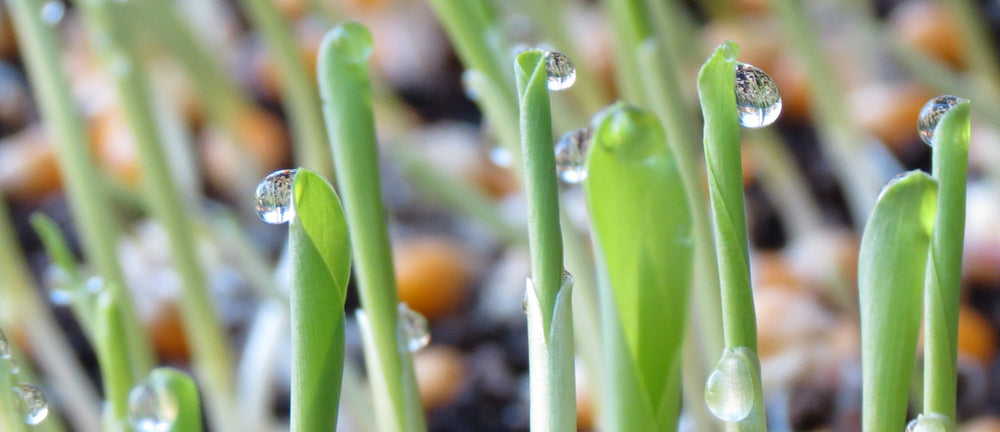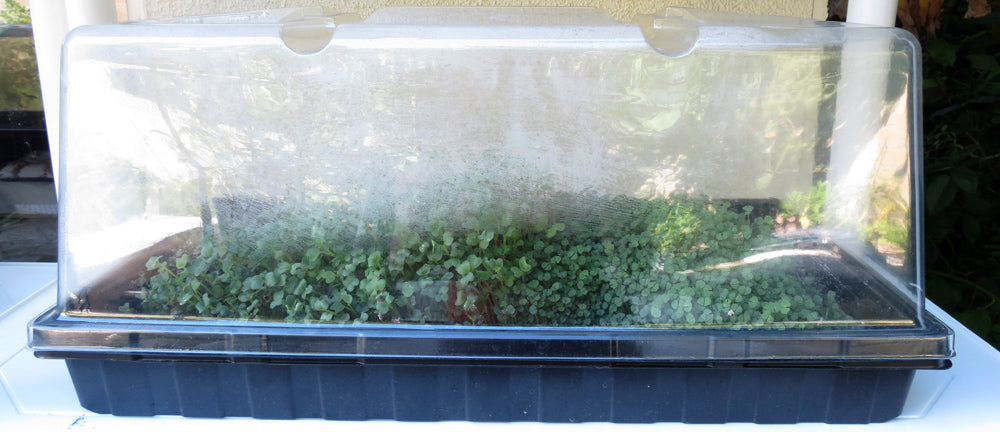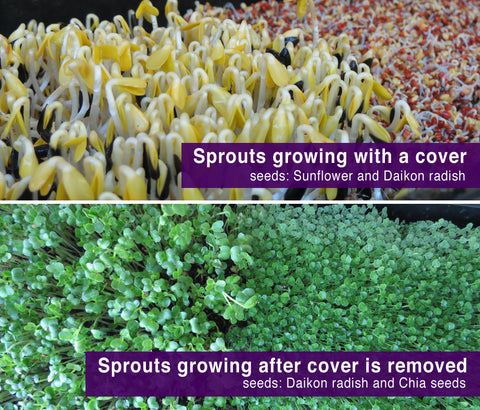Why You Should Eat Sprouts September 07 2016

Sprouting is an excellent way to grow your own nutritious food in a short period. A tray of sprouts can be grown in just 1-2 weeks! It's a great choice for anyone, but particularly beneficial if you are limited to outdoor gardening during the colder months.
Sprouts are at least 10-30 times more nutrient dense than a full grown plant. During the sprouting stage, they contain a much higher content of enzymes, vitamins, essential fatty acid and fiber than fresh fruits and vegetables. These nutrients are also easier for our body to absorb during this stage.
My Favorite Seeds To Sprout
There's all kinds of seeds you can sprout, but my top favorites are sunflower seeds, mung beans, and Chia seeds. If seeds are fresh, they take just 2-5 days to sprout usually. The warmer the room is, the faster they begin sprouting. I enjoy sunflower sprouts and mung bean sprouts the most because of the nutty flavor, and crisp texture.
 How To Sprout In A Jar
How To Sprout In A Jar
I highly recommend beginners to start using this method since this is the easiest way to sprout. In the warmer months I particularly enjoy sprouting mung beans in a mason jar. The warmth of the room makes them sprout as quickly as one day! The fresher the seeds are, the faster they will sprout.
The entire process should only take 2-5 days usually. If the seeds take a week or longer to sprout, they are too old. Keep in mind not every seed will sprout either, but majority of them should.
Pick up a sprouting jar at any health food market, or home & kitchen shop. You'll need a glass jar with a mesh wire lid to allow air circulation.
Let's Begin!
1. Place a small hand full of seeds in the sprouting jar then fill it with drinking water. Let it soak overnight, and the seeds will expand at least 50% more than when they were dried.
2. By the next morning, drain and rinse the seeds then keep the jar in a bright, cool location (70-80F is ideal). Usually anywhere on the kitchen counter that does not get direct sunlight would be fine.
3. Rinsing helps to keep seeds clean, and prevents mold or fermentation occurring so each day rinse the seeds 1-2 times. In a warm room, rinse at least 2 times per day. Repeat this step until the sprouts grow to the length you like. I prefer anywhere between 1/2 - 1 inch.
4. When sprouts reach the length desired, they are ready to go on your dinner plate! Store the jar or transfer it to another container and keep in refrigerator. The cold will stop the sprouting process, and keep them fresh.

How To Grow Sprouts In Soil
I use a tray to grow sprouts in soil. This allows me to grow more sprouts than a jar. I can also get the sprouts to grow up to around 3 inches, or until the first true leaf begins to show on the sprout.
Sprouting in soil is great for sunflower seeds, kale, daikon radish, corn, peas, wheat grass and so much more! Normally sprouts grown in soil, or any kind of growing medium is called micro greens. These plants are just a tiny bit older than sprouts you grow in a jar. The entire process takes about 1-2 weeks depending on the seeds you choose.
You can use organic indoor potting soil, or coconut coir for the seeds to set roots in.
 As for the tray, I highly suggest purchasing a seed growing tray at your local nursery, Orchard Supply Hardware, or hydroponic shop. For growing micro greens, you would need a 3 tray setup. These growing trays are very inexpensive, and make it much easier to grow abundance of food.
As for the tray, I highly suggest purchasing a seed growing tray at your local nursery, Orchard Supply Hardware, or hydroponic shop. For growing micro greens, you would need a 3 tray setup. These growing trays are very inexpensive, and make it much easier to grow abundance of food.
Why 3 trays would be ideal for growing micro greens: 1 tray has holes for drainage. The other 2 do not have holes. The tray with holes is the one seeds will be planted in, and this sits on top of the tray without holes so it can catch any excess water. The third tray will be used for covering the top to keep dark, and help retain humidity.
I prefer seed growing trays since it's shallow and wide, but you can use something as simple as a regular pot for plants since these have holes for drainage. You can also find any plastic containers and poke holes on the bottom, and use a baking tray to put underneath.
 Let's Begin!
Let's Begin!
1. Place about 1/2 inch of then lay a thin layer of seeds closely together on the top.
2. Mist soil and seeds with a water spray bottle to moisten. Do not over water. Soil just needs to constantly stay damp. When finished, cover the top.
3. Keep tray in a cool location without direct sunlight.
4. Check on the tray daily, spray water when needed. You will start to see sprouts peeking through the soil in a few days.
5. Once the plants grow to about 2 inches, keep the tray uncovered and move it to a brighter location if needed. By uncovering it, you are encouraging chlorophyll to produce. This takes around 2-3 days.
6. When the micro greens turn green, they are ready to enjoy. Take a pair of scissors to harvest!
Where To Purchase Seeds?
There's many websites that carry seeds for sprouting. If you want to support small businesses, check Etsy.com. You can also purchase from the isle that carry grains at the grocery store.
Tips On Using Seeds From Your Garden
Sunflowers are enjoyable to grow in the garden. When they finish blooming, seeds can be collected to use for sprouting. After leafy greens have bolted, allow the plants to produce seeds so they can be collected to grow the next season and to use for sprouting.

Ways To Eat Sprouts
Seeds contain all the nutrients plants need to start life; thus, we can benefit greatly when eating them. Add these in sandwiches, salads, garnish on soups or any entrée, even mix with snacks.
This will be a fun project with children, or just to help get more greens in your diet. Thanks for reading. Share your tips with us below, and tell us what your favorite sprouts are!
